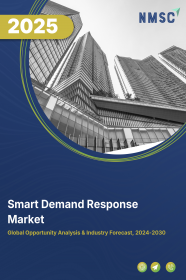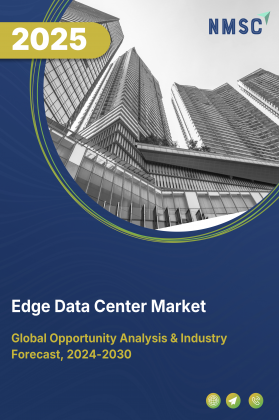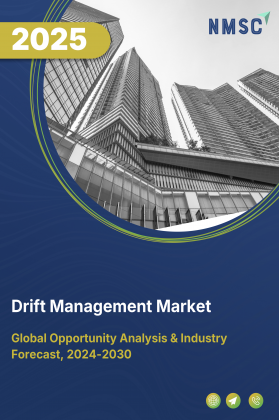
Smart Demand Response Market by Type (Voluntary and Contractual Mandatory), by End User (Residential, Commercial, and Industrial) - Global Opportunity Analysis and Industry Forecast 2022-2030
Market Definition:
Global Smart Demand Response Market size was valued at USD 28.1 billion in 2021 and is predicted to reach USD 75.5 billion by 2030 with a CAGR of 10.8% from 2022-2030.
Smart demand response is a system to screen & track the power utilization in different industries with an objective to reduce the energy consumption. These systems are used by various electric utility companies and operators for balancing the supply and demand of electricity. It does it by offering consumers the option to select non-essential loads that can be shed at peak times.
As smart grids are programmed to respond to the highest potential demand, reducing consumption during demand intensive times of the day helps electric companies minimize overall installation and operating costs. It also helps in preventing potential grid failures and can significantly reduce the cost of electricity in the wholesale market, which in turn reduces the price to the end-users.
Market Dynamics and Trends:
The demand for smart demand response system is increasing as modern buildings are adopting DR programs for safeguarding their electric grid at the time of high energy demand. In addition, factors such as increasing installations of smart meters and use of smart grid technologies are expected to propel the growth of the market. Moreover, extensive infrastructural developments as well as the implementation of favorable government policies are anticipated to drive the growth of smart demand and response market.
However, high cost of technology and equipment along with limited customer awareness regarding demand response system are the factors expected to restrain the growth of the market. On the other hand, reforms in the power sector and development of decentralized electricity systems are expected to create ample growth opportunities for the market players in the coming years.
Market Segmentations and Scope of the Study:
The smart demand response market size is segmented based on type, enterprise size, end user and geography. Based on type, the is classified into voluntary and contractual mandatory. Based on end user, the market is classified into residential, commercial, and industrial. The geography breakdown and analysis of each of the aforesaid segments includes regions comprising of North America, Europe, Asia-Pacific, and ROW.
Geographical Analysis:
Asia-Pacific region holds the lion share of smart demand response market and is expected to continue dominating the market throughout the forecast period. This is attributed to factors such as increasing use of smart meters and government emphasis to use smart demand response systems. Furthermore, urbanization in countries such as China and India have led to an increase in electricity demand, which in turn has resulted in to high demand for the smart grid system in this region.
On the other hand, market across North America region is expected to show a steady rise in the smart demand response market due to high R&D investments and consumer awareness regarding smart demand response systems. Also, presence of several market players such as ABB, Hitachi Ltd, Mitsubishi Electric Corporation, Eaton Corporation PLC and General Electric Company owing to which the market is expected to witness growth in this region.
Competitive Landscape:
The market is comprised of various players such as ABB, Hitachi Ltd, Mitsubishi Electric Corporation, Eaton Corporation PLC, General Electric Company, Honeywell International Inc., Itron Inc., Johnson Controls International plc, Oracle Corporation, Schneider Electric SE, and Siemens AG. These market players are adopting various joint venture strategies and planning expansion of business across various regions to maintain their dominance in the smart demand response market.
For instance, in January 2020, AutoGrid and Schneider Electric announced a Fully integrated ADMS and DERMS Solution to digitize the electric grid of the future.
Key Benefits:
-
The smart demand response market report provides the quantitative analysis of the current market and estimations through 2022-2030 that assists in identifying the prevailing market opportunities to capitalize on.
-
The study comprises a deep dive analysis of the smart demand response market trend including the current and future trends for depicting the prevalent investment pockets in the market.
-
The information related to key drivers, restraints and opportunities and their impact on the smart demand response market is provided in the report.
-
The competitive analysis of the market players along with their market share in the smart demand response market
-
The SWOT analysis and Porters Five Forces model is elaborated in the study.
-
Value chain analysis in the market study provides a clear picture of the stakeholders’ roles.
Key Market Segments:
By Type
-
Voluntary
-
Contractual Mandatory
By End User
-
Residential
-
Commercial
-
Industrial
By Geography
-
North America
-
U.S
-
Canada
-
Mexico
-
-
Europe
-
UK
-
Germany
-
France
-
Italy
-
Spain
-
Rest of Europe
-
-
Asia-Pacific
-
China
-
India
-
Japan
-
South Korea
-
Australia
-
Rest of Asia-Pacific
-
-
RoW
-
UAE
-
Saudi Arabia
-
South Africa
-
Brazil
-
Remaining Countries
-
Key Market Players:
- ABB
- Hitachi Ltd
- Mitsubishi Electric Corporation
- Eaton Corporation PLC
- General Electric Company
- Honeywell International Inc.
- Itron Inc.
- Johnson Controls International plc
- Oracle Corporation
- Schneider Electric SE
- Siemens AG
REPORT SCOPE AND SEGMENTATION:
|
Parameters |
Details |
|
Analysis Period |
2021–2030 |
|
Base Year Considered |
2021 |
|
Forecast Period |
2022–2030 |
|
Market Size Estimation |
Billion (USD) |
|
Market Segmentation |
By Type (Voluntary and Contractual Mandatory), by End User (Residential, Commercial, and Industrial) |
|
Geographical Segmentation |
North America (U.S., Canada, Mexico) Europe (UK, Germany, France, Italy, Spain, Rest of Europe), Asia-Pacific (China, India, Japan, South Korea, Australia, Rest of Asia-Pacific), Rest of the World (UAE, Saudi Arabia, South Africa, Brazil, Remaining countries) |
|
Companies Profiled |
ABB, Hitachi Ltd, Mitsubishi Electric Corporation, Eaton Corporation PLC, General Electric Company, Honeywell International Inc., Itron Inc., Johnson Controls International plc, Oracle Corporation, Schneider Electric SE, and Siemens AG. |




















 Speak to Our Analyst
Speak to Our Analyst

























